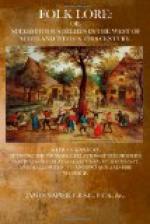PREFACE
The doctrine taught concerning Satan, his motives and influence in the beginning of this century, supplied the popular mind with reasons to account for almost all the evils, public and private, which befell society; and as the observed ills of life, real or imaginary, greatly outnumbered the observed good occurrences, the thought of Satan was more constantly before the people’s mind than was the thought of God. Practically, it might be said, and said with a very near approach to truth, that Satan, in popular estimation, was the greater of the two; but theoretically, the superiority of God was allowed, for Satan it was believed, was permitted by God to do what he did. It was commonly said, “Never speak evil of the Deil, for he has a long memory.” This Satanic belief gave rise to a great amount of Folk Lore, and affected the whole social system. Historians who take no account of such beliefs, but regard them as trivialities, cannot but fail to represent faithfully the condition and action of the people. Folk Lore has thus an important historical bearing. Every age has had its own living Folk Lore, and, beside this, a residuum of waning lore, regarded as superstitious, and so it is at the present day. When we speak of the Folk Lore of our grandfathers and great-grandfathers, we believe that we are speaking of beliefs which have past away, beliefs from which we ourselves are free; but if we consider the matter carefully we will find that in many respects our beliefs and practices, although somewhat modernized, are essentially little different from those of last century. Among the better educated classes it may be said that much of the superstitions of former times have passed away, and as education is extended they will more and more become eradicated; but at present, in our rural districts especially, the old beliefs still linger in considerable force. Many think that the superstitions of last century died with the century, but this is not so; and as these notions are curious and in many respects important historical factors, I have thought it worth while to jot down what of this Folk Lore has come under my observation during these last sixty years.
In this collection I do not profess to include all that may come under the head of Folk Lore, such, for example, as the reading of dreams and cups, spaeing fortunes by cards or other methods—that class of superstitions by which designing persons prey upon weak-minded people.
One principal object which I had in view in forming this collection, was that it might supply a nucleus for the further development of the subject. The instances which I have adduced belong to one locality, the West of Scotland, and chiefly the neighbourhood west of Glasgow, but different localities have different methods of formulating the same superstition. By comparison, by separation of the local accretion from the constant element, an approach to the original source and meaning of a superstition may be obtained.




